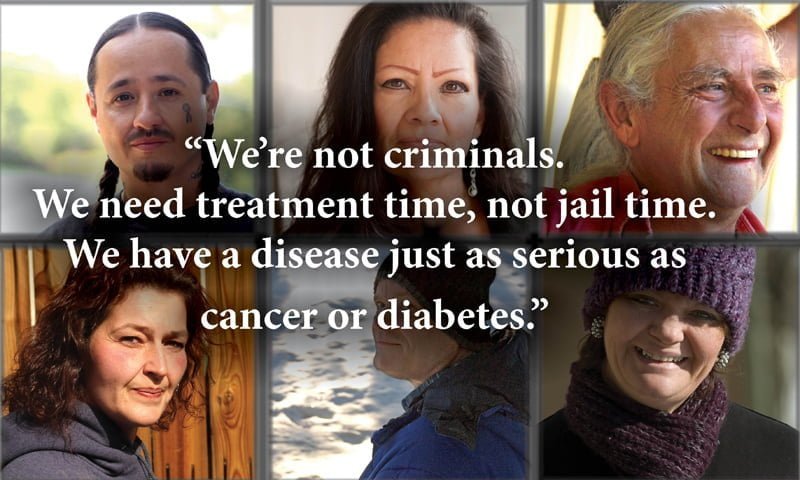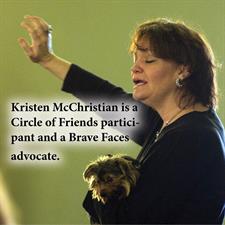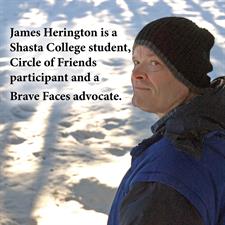
October 9, 2015

The Brave Faces and Voices project began in 2012 as a way for Shasta County residents to reduce stigma and shame associated with mental illness and suicide by telling their inspiring stories of recovery. Nearly 30 people have bravely come forward to share their experiences with the goal to debunk pervasive stereotypes that prevent people from seeking help and support.
Many of them have also shared how their mental health struggles were connected to substance abuse and addiction, what’s called co-occurring disorders in the mental health field. Myths about substance abuse, the people who suffer from it and treatments are widespread.
To promote healing and understanding as well as to save lives, here are the top realities about substance abuse the Brave Faces Advocates want you to understand.

Whitmore resident: “We’re often treated like we’re all criminals and deserve jail time instead of treatment time. When I was at my worst before my recovery, I was a very functional drug addict and alcoholic who worked for [Mendocino] County full-time.
People with addiction have a disease just as serious as cancer or diabetes, and there are many mitigating factors that can cause it, like mental illness, physical disabilities, or environmental stressors.”
James Herington, Burney resident: “Some people get so wrapped up in their own stigma. They hear people calling them losers and that they’re scum of the earth because they’re addicted to something. That carries over and people start to believe it about themselves.
I was inspired to get clean by watching family members who were able to stop because they were thinking about their lives and wanted a better future for themselves.”
City of Shasta Lake resident: “There’s a lack of self-awareness when you’re addicted. They might be doing bad things when they’re sick and on drugs: stealing from family members, robbing and cheating. But really they’re good people who are just sick.”

Ripley Wolf, Redding resident: “A lot of times someone is self-medicating a brain condition. I developed Post-Traumatic Stress Disorder at a young age, and the first time I felt a release was when I had my first drink of alcohol at the age of 9. I used alcohol for a long time to keep my PTSD under control. I had no idea it was a depressant or that I could access other ways to treat my PTSD.”
Sara Fabila: “It’s always about relief. People resort to addictions in order to change the way they feel rather than treating the problem. But addiction brings on more and more problems, and it becomes a cycle because it numbs you. I didn’t know the severity of my addiction until I lost my children.”
“I really struggled after an abusive relationship. I was living in a household where I had to walk on egg shells, and then I didn’t do so well after the divorce. There are people who’ve never gone through it, and they don’t understand. Or they don’t want to understand. They think someone like me did it ‘just to get high.’”

Kristen McChristian: “I lost myself in my addiction. I went from an upper middle class home to living at the Mission, and then to living by myself on the streets by the railroad tracks.”
Mike Skondin, Redding resident and veteran of the Marine Corps: “When I returned home, I was suffering from PTSD and didn’t realize it. I was scared. I was paranoid. I started to pollute my body to mask the fear I had because I didn’t have any control of what was happening to me.
I was seeking out violence because it was the only way to get the adrenaline rush I got from life-and-death situations. I realize now that I was using high doses of heroin to sedate myself so I wouldn’t go out and get into fights.”
Ripley Wolf: “I entered 12-Step recovery 29 years ago and have attended meetings in vie countries. My brothers and sisters in recovery have included the following: Surgeons, lawyers, socialites, computer scientists, laboratory scientists, artists, professors, high school teachers, nurses, business people, priests and others. I was married to a violent psychiatrist for almost 20 years whose untreated addiction destroyed two families. The heartbreaking reality is that addiction strikes at all levels of society.”
Sara Fabila: “I was court ordered into a drug treatment program, and that’s where I started to face myself. I needed to address the disease of addiction, but also learned to modify my behavior. I needed to be removed from my environment to start the process of recovery.”

Greg Burgin Jr.: “For me getting sober started with hitting bottom. We all have a bottom and some are lower than others. I was sick and tired of being sick and tired, and I knew in my heart that I needed help. Quitting is much more than stopping the use but also healing the wounds that led to the substance abuse. There are things I learned from 12-step programs, talking circles and from my tribal elders.”
Mike Skondin: “Once I started a 12-step program, I started realizing I had to rebuild my morals and figure out what healthy boundaries are. I realized I was no longer responsible for your feelings if I told you no. It was freeing. It was a huge burden off my shoulders.
I had lived a long time in unhealthy environments, but it was what it was. Everyone was doing the best with the information they had. For me, recovery became about seeking and using the information I’d been missing.”
Tammy Hebert, Cassell resident: “I was a certified drug and alcohol counselor and was sober for four years, doing good in the mental health field. But then I relapsed after getting involved in an abusive relationship.

Not everyone can get through it the first time. Sometimes it’s a trial and error process in figuring out what you need to stay sober and how you can handle all the bumps that come on the road of life.”
Greg Burgin Jr.: “Sobriety is a long walk and sometimes a lonely one. If we stay strong, go to meetings and stay in a healthy environment, we can change.
After I got into trouble with the law, I had to go to a court-ordered 12-step program and I quit drinking for two years. When construction jobs in the Bay Area bottomed out, I had to move into my grandmother’s backyard in Shasta Lake where we lived in tents. I had no friends, and my children were with their mother, so I started drinking again. I was up to drinking a 24-pack of beer a day before I got connected with ceremony and the Wintu community.”

James Herington: “A lot of times people stigmatize themselves so they don’t believe they’re going to get better if they go to rehab or to a psychiatric hospital. They fear they’re going to be in there forever. They don’t have the understanding that they can change.”
Sara Fabila: “It’s not something to be ashamed of. We don’t have to be defined by it. We can make a difference by saying we do have value and this addiction is just one part of me. It’s not who I am. It doesn’t define me. We can stand up for ourselves by pursuing our dreams, becoming healthy and contributing to society.”
*Not pictured: Ripley Wolf and Mike Skondin, Brave Faces advocates.
Share this Story

© Copyright 2021 – Stand Against Stigma – All rights reserved. | Websites By: prime42